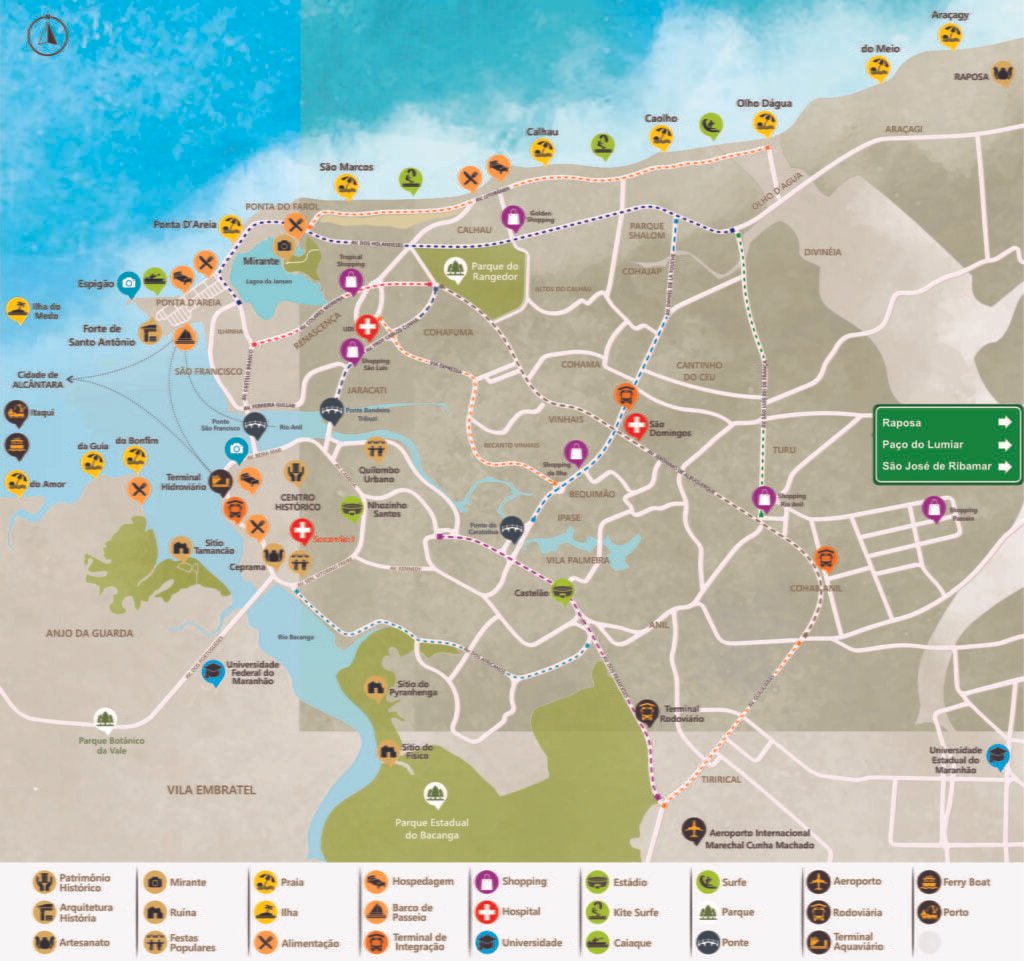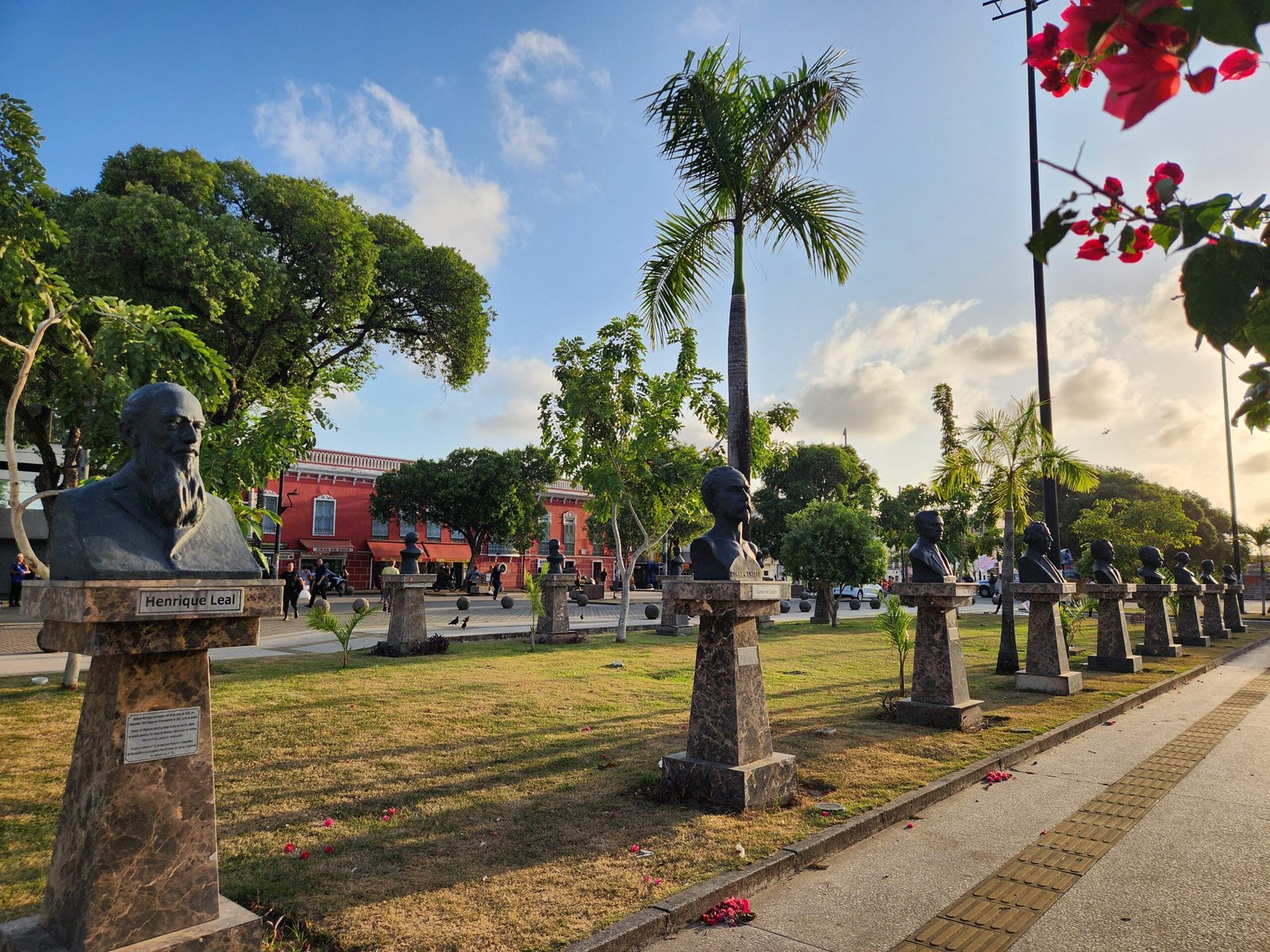AN ISLAND ON THE OCEAN
São Luís is an island in the Atlantic Ocean that holds a breathtaking wealth of history, culture, and natural beauty, even for those who call it home.
Even being a capital, the city maintains a less hurried pace compared to other Brazilian capitals. This adds a charm that, combined with all its attractions, provides a tourist experience like no other.
Located in the Northeast region of Brazil, the city is situated at the northern tip of Maranhão, occupying a significant portion of a territory formed by the cities of São José de Ribamar, Raposa, and Paço do Lumiar, together forming the so-called metropolitan region of São Luís.
São Luís is 24 kilometers from São José de Ribamar (MA).
São Luís is 28 kilometers from Raposa (MA).
São Luís is 24 kilometers from Paço do Lumiar (MA).
São Luís is 89 kilometers from Alcântara (MA).
Distance from São Luís to Brazilian capitals
São Luís is 436.9 kilometers from Teresina (PI).
São Luís is 891 kilometers from Fortaleza (CE).
São Luís is 1,170 kilometers from Belém (PA).
São Luís is 1,251 kilometers from Palmas (TO).
São Luís is 2,915 kilometers from São Paulo (SP).
São Luís is 3,141 kilometers from Rio de Janeiro (RJ).
São Luís is 1,996 kilometers from Brasília (DF).
São Luís is 1,581 kilometers from Salvador (BA).
São Luís is 1,559 kilometers from Recife (PE).
São Luís is 2.458 kilometers from Belo Horizonte (MG)
São Luís is 3.316 kilometers from Curitiba (PR)
Find out how to get to São Luís do Maranhão

By the road
By land, access to São Luís is via BR 135 highway, connecting this city directly to the mainland and passing through states such as Minas Gerais, Bahia, and Piauí.
São Luís has an intercity bus terminal from which regular bus lines depart and arrive at various cities in Maranhão and the country. The São Luís Bus Terminal features ticket counters, taxi stands, urban bus stops, commercial shops, pharmacies, convenience stores, restaurants, a bank branch ATM, a police station, a Juvenile Court unit, and a rotating parking lot.
By Airplane
There are direct flights to São Luís, as well as connecting flights arriving and departing daily from Marechal Cunha Machado International Airport. Located at the city’s entrance, the airport operates with airlines such as Azul, Gol, and Latam, connecting this destination to major capitals and cities across the country.
By Train
It is possible to arrive in and depart from São Luís by railway as well. The city is served by a passenger train through the Carajás Railway, operated by Vale do Rio Doce company, connecting the capital of Maranhão to Parauapebas in the southeast of Pará. Along the route between the two cities, the railway makes a total of 15 stops in municipalities of Maranhão and Pará.
Ticket purchases can be made online through the website or in person in São Luís at the Anjo da Guarda Railway Station.
By Ocean
The city has two waterway infrastructures that operate maritime vessels with regular arrivals and departures to São Luís:
Ferry Boat: Operating daily passenger, cargo, and vehicle transportation, this service connects São Luís to Baixada Maranhense and the northern region of Brazil. Access in São Luís is through the Ponta da Espera Terminal, and in Alcântara, through the Cujupe Terminal.
Tickets can be purchased in person at the Terminals (Ponta da Espera and Cujupe) or online on the websites of the companies operating the ferries.
Hidroviário Terminal da Praia Grande (Rampa Campos Melo): Located at Cais da Praia Grande, in the Historic Center of São Luís (in front of Casa do Maranhão), the ferry terminal operates with fishing vessels and offers domestic trips directly to the city of Alcântara (MA), with an average duration of 1 hour and 15 minutes. The departure and arrival times of the vessels vary depending on the sea level at the beginning and end of the day.
The schedule with the daily travel times and more information can be checked on the official communication channels of the two companies operating at the Terminal: Lancha Bahia Star (@lanchabahiastar) e Iate Luzitana.

Weather
In this tourist destination where architectural, cultural, and natural heritage stand out as elements that differentiate, enchant, and embellish visitors’ experiences, the climate is tropical with two well-defined seasons and varying levels of sun and rain throughout the year. In December, rainfall is typically low, escalating in the subsequent months and reaching its peak in February, March, and April.
These climatic conditions ensure that outdoor activities, including tours, can be enjoyed year-round, contributing to the city’s consistent tourist flow.
Throughout most of the year, the capital records minimum temperatures of 24°C (mainly at night) and maximum temperatures ranging between 30°C and 34°C. Due to its coastal location and proximity to the Equator, the city experiences winds that help dissipate high temperatures consistently. In December, rainfall is typically low, escalating in the subsequent months and reaching its peak in February, March, and April.
The period of increased tourist activity in São Luís is between June and December. In June and July, the city celebrates the pinnacle of its popular culture. This is when the best festivities in honor of São João take place, featuring performances by Bumba meu Boi groups, Cacuriá, Tribos de Índio, Dança do Côco, Dança Portuguesa, Tambor de Crioula, among others, in “arraials” scattered throughout the capital.
Electric current for household appliances
As in much of the northeast, the domestic electrical voltage in São Luís do Maranhão is 220v.


Public transport in São Luís
São Luís’s public transportation is powered by two systems operating urban (São Luís) and semi-urban (Metropolitan Region) bus lines. The city does not have a subway or rail vehicles available for passenger transport, but it features five Integration Terminals capable of connecting all lines in this system.
Buses run throughout the day, starting their routes around 5 a.m. and continuing into the early morning. After this period, the city is served by the so-called ‘corujões,’ which are lines that run overnight, serving specific regions of the city.
The fare for bus use can be paid in cash, student cards, or transportation vouchers. There is no specific card for visitors to use on buses; they must pay the fare upon boarding or at the integration terminal where they embark.
In the Praia Grande neighborhood, located in the Historic Center of São Luís, there is the integration terminal of the same name as this neighborhood. Through this terminal, tourists can access all regions of the city, including beaches, parks, shopping malls, universities, bus stations, airports, and commercial centers. In São Luís do Maranhão, passengers board through the front door and exit through the back door.
Bike rental
The most beautiful beaches for you to experience and explore on two wheels. Bike rides in São Luís are a great attraction for those who value well-being, natural beauty, and a sense of freedom.
Commonly practiced by island residents, the shared bike service (for adults and children) is offered by private companies strategically located to provide safe rental services on the Espigão Costeiro (Ponta d’Areia) and along Avenida Litorânea, spanning the waterfront of Praia de São Marcos, Praia Litorânea, Praia do Caolho, and Praia do Olho d’Água.
Throughout this entire stretch of the boardwalk along Avenida Litorânea, tourists will find lighting, security, signage, and a bike path close to kiosks, restaurants, snack bars, pubs, bars, and hotels.
On Sundays, part of Avenida Litorânea is completely closed off, allowing tourists and the population to freely use the entire space for sports and leisure activities.


Where to park my motorhome in São Luís do Maranhão?
For fans of the lifestyle who adopt the motorhome as their home, São Luís offers public parking in its Espigão Costeiro, one of the main gateways to the tourist destination.





